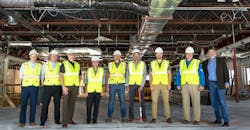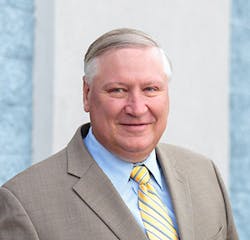As a Wisconsin Manufacturer Returns to Its Roots, an Export Education Pays Off
Gamber-Johnson started out making hi-fi stereo cabinets at their factory in Stevens Point, Wisconsin, in the 1940s and ‘50s, when every self-respecting suburban ranch house had one. The company was on trend again when trucker culture caught fire, inventing mounting systems for CB radios that let armchair long-haulers detach their CBs from their cars and take them wherever they wanted to channel the Rubber Duck. That led to mounts for police radios, which led to mounts for computers in the 1980s and ‘90s.
Today, company now primarily manufactures rugged mounting systems for fleet and public-safety vehicles and semi-trucks and has been carving out a new niche for itself in the export arena. Since 2015, its revenue has more than doubled and international sales have increased 400%.
IndustryWeek talked with Brian Wagner, CEO, who joined the company in 2008 after spending 21 years in technical sales for a German carbon graphite manufacturer. At the time, Gamber was owned by Leggett & Platt, a diversified manufacturing company on the S&P 500. But in 2016, thanks to the financial investments of Wagner and five other executives at Gamber, along with Main Street Capital, Gamber is now back to being an independent, privately owned manufacturer and is nearly tripling the size of its headquarters manufacturing facility in Stevens Point to 130,000 square feet. In 2020 the company, which has 165 employees (and annual revenue in the neighborhood of $50 million), was named Wisconsin Manufacturer of the Year by the Wisconsin Manufacturers and Commerce. It is the state's highest award for manufacturing.
Tell me about the early days of your tenure. You joined Gamber at the height of the Great Recession.
It was a tough time. And it was tough for people to kind of get their heads around it as well. I remember a lot of battles of beginning to try and get people toWe did end up downsizing the business quite a bit; we went from about 95 employees down to 52. And we kind of bottomed out for roughly about three years, from 2010 to 2012. The phenomenon in our business was such that we tended to have a relatively gentle decline, but a relatively slow and gentle recovery. (Above: Gamber-Johnson CEO Brian Wagner)
as well. It took us a little longer to get out of the recession that a lot of companies in the industry.
How did things start to turn around?
In 2012, we started on a program called ExporTech, through the Wisconsin MEP. They taught us how to systematically develop the export market and enabled us to grow. We were doing about $200,000 a year or so in exports at that time. We’re over $9 million in export sales now. Our overall growth really coincided with the export expansion. It’s attributable to the techniques and the resources that we were able to develop and tap into this export technical boom.
Where did you see opportunity when you partnered with private equity and bought the company?
The main opportunities for growth involved more aggressively investing in the business. We increased not only our capital expenditures, but also our selling resources. When I started with the company, we had five field sales people. Now we're up to 19, all over the world. With the investment in capital equipment, it was primarily tooling to do projects and get into new markets that we hadn’t in the past.
We followed that up by increasing our engineering resources for product development by 60%. Under Leggett, they used a portfolio management philosophy and we were considered to be a cash cow. We were charged with generating cash, with a little investment supporting our business, but really not with an impetus to grow the business. We started partnering with Main Street; they were interested in us and that enabled us to to be more aggressive with the investment business and paid off very well.
In what markets did you see opportunities for growth?
We made an acquisition in Canada of a large competitor in 2017. Our growth in Canada has been substantial, but we don’t include that in our definition of foreign markets. Then the growth in international; we made a major investment there. Panasonic is one of our computer partners, and we did more or less a bargaining agreement with them to buy them out of their own vehicle docking-station manufacturing.
We have also grown dramatically in the materials handling and logistics market, primarily warehousing, with computer mounts for forklifts but also over-the road semi-trucks. The ELD Mandate (a requirement beginning in 2019 that all commercial carriers in the U.S. have an electronic logging device) has created quite a bit of growth in that area.
And then the third area of growth has been in his semi-rugged [mounts] or just a level of ruggedness below what the typical rugged computer manufacturers produce—companies like Panasonic, GTech, Dell.
Companies like Samsung came in and developed some rugged computers that are nearly at the level of the fully rugged devices, but at a much lower price point. And they're also smaller, lighter-weight devices. Samsung opened up a whole segment of market that demanded something more than the consumer grade but at a lower price point than the fully rugged. We've grown dramatically with Samsung all over the world. And a lot of our our developing nation growth has come through projects with Samsung, where they've been able to get technology into places that previously weren't going to make the huge investment that it takes to get into fully rugged devices.
We switched to quick-response offices in our product development, and these are in essence businesses within a business. We employ a technique where we evaluate the decisions that are being made, and we push the decision-making as close where the actual day-to-day activities are taking place as possible. For the most part, 80% of the decisions have been pushed down to the lowest possible level in our organization.
Who are your customers in developing nations?
It depends on the country. With countries that are more socialist—like in Mexico, the oil and gas industry is government-owned—you end up with a quasi-government sort of entity. Oil and gas has been a big area of growth for us. We’ve done work in taxi cabs, in mining, which were private enterprises. The majority has been private sector, rather than government.
What were some important takeaways from the ExporTech program?
We learned to start with three target markets, and you do your research and validate the assumptions that you've made about those markets quickly, so that you don't spend a lot of time languishing. If it's not working out, stop your activities in that market and move to another.
ExporTech also made us aware of a lot of resources that were out there and how you can tap into them. Tools through the U.S. Department of Commerce and state of Wisconsin. There are a number of private enterprise freight forwarders and other people who deal in the import-export world. The state of Wisconsin offers market expansion initiatives, usually in the form of a matching grant.
What were the three markets that you started with?
Europe, the Middle East and Brazil. All the market indicators led us to believe that Brazil would be a great opportunity. It was right before the Olympics down there—they were investing a lot in security. Lo and behold, it was not it was very difficult to get into. We now do a good chunk of business in Brazil.
Has the pandemic affected business?
It's caused some softness in the market. What we call the enterprise side—field service, utility telecom markets, those were soft early on. And now it seems to be the softening is occurring more at the public sector side, especially public safety with police budgets, people who are dependent on government budgets, which are dependent on tax revenues. They're struggling, and we think they're going to be pretty slow to recover. Winning state budgets is going to be pretty hard in the next year to two years with reduced tax revenues and budgets that get cut. So we're expecting some softness in that area to continue. But the enterprise market has started to rebound a bit now.
Where do you see new opportunities?
One community we're working with on the West Coast, when they have people with mental health issues, is dispatching mobile response teams that include a psychologist or psychiatrist, a social worker and a police officer, instead of dispatching police officers that may not be well-trained to deal with the dispatch. They’re making a significant investment there in vehicles for that. And those vehicles all have technology that we support.
There’s a workforce shortage in many regions. How hard is it to fill positions in Stevens Point?
Not very easy. It’s been a challenge. Before COVID, our unemployment rate was under 3%. And Wisconsin doesn't have a lot of population growth going on; it's declining in the more rural parts of the state. The skills gap is not our primary issue any longer. It's now a body gap. Before COVID, there were more jobs available than there were people of working age. So we’re at a pretty critical juncture. We're doing a lot to try and drive productivity, drive efficiencies. We've put in three collaborative robots. And success with that, so we're looking to expand that.
Have you been affected by the U.S./China tariffs?
We have very limited capacity in this country for making plastic injection molding tooling for making printed circuit boards. But yet they were subject to tariffs. So that was really problematic.
How much have the tariffs cost Gamber, do you know?
I believe in 2019 it cost us about $400,000. I don't know what 2020 number is.
What’s your starting wage for a production worker?
Our average wage when we convert somebody from temp to permanent is starting right around $13, $13.50 an hour. And with the labor shortage, we're constantly evaluating that. Retailers like Target are saying $15 an hour starting now. So I have to continually monitor that just to make sure that we can stay competitive.
Main photo: Wagner, second from right, and Gamber associates check out the company's in-progress manufacturing expansion.
Got a manufacturing executive candidate for IndustryWeek's Profiles in Leadership? Contact leadership editor Laura Putre.
About the Author

Laura Putre
Senior Editor, IndustryWeek
As senior editor, Laura Putre works with IndustryWeek's editorial contributors and reports on leadership and the automotive industry as they relate to manufacturing. She joined IndustryWeek in 2015 as a staff writer covering workforce issues.
Prior to IndustryWeek, Laura reported on the healthcare industry and covered local news. She was the editor of the Chicago Journal and a staff writer for Cleveland Scene. Her national bylines include The Guardian, Slate, Pacific-Standard and The Root.
Laura was a National Press Foundation fellow in 2022.
Got a story idea? Reach out to Laura at [email protected]

